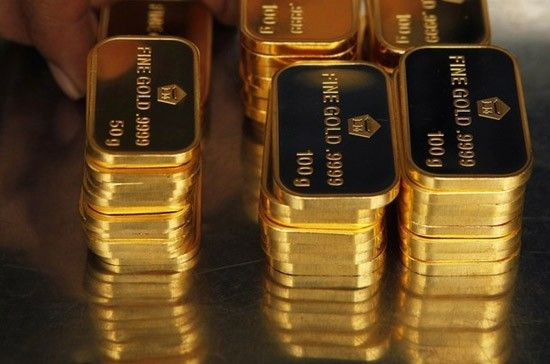Gold Prices Steady After Last Week's Fall

(REUTERS) -- Gold steadied above two-month lows on Monday, following its largest weekly fall last week in three months, as evidence of investor and central bank demand in recent weeks helped offset the negative impact of a weaker euro.
Spot gold was up 0.1 percent on the day at $1,654.90 an ounce by 1124 GMT, having fallen by more than 3 percent last week.
Investors have become more confident in the prospects for the U.S. economy after three weeks of consistently upbeat data, which have prompted some reassessment of the rate outlook and removed some of the desire to hold gold as insurance against another slowdown.
The resulting steep rise in benchmark 10-year U.S. Treasury yields, which supports the dollar, has weighed on gold. Gold's correlation to Treasury prices has turned positive in the past two weeks, meaning that it is more likely to move in the same direction as U.S. bond prices.
Speculators cut their holdings of gold futures to their lowest in two months last week, according to data on Friday, although longer-term investors did not follow suit, as evidenced by the rise last week in holdings of gold in exchange-traded products to another record high.
Central banks have also reportedly been active buyers of gold in recent weeks, having bought as much as 4 tons of metal, according to an industry source and the Financial Times on Friday.
ETF holdings show long-term investors are still loyal to gold. We've seen no meaningful outflow from the ETFs over the last couple of weeks, and I think the $1,650 level will be used for bargain-hunting, Daniel Briesemann, an analyst at Commerzbank, said.
CORRELATION TO COPPER, OIL
Gold still has quite a high correlation to (industrial) commodities, which haven't really gained in the last week from the better economic sentiment and the better mood on the markets, and this is probably why gold is down as well, he said, referring to the tight positive relationship between the bullion price and crude oil or copper.
The euro was down around 0.1 percent on the day. Although some of the strains on the euro from the debt crisis have abated, investors are still running bearish positions in the single European currency.
Holdings of gold in the world's largest ETPs rose by more than 40,000 ounces last week to reach a record 70.889 million ounces, marking their most modest weekly inflow since early February.
ETP holdings of gold have risen for 10 straight weeks, driven mostly by inflows into the main North American funds.
Central banks, which were net buyers of gold last year to the tune of 439.7 tons, bought around $250 million worth of metal last week through the Bank for International Settlements.
Shorter-term investors were not quite so responsive to the price drop, reflected in a second consecutive week of a contraction in the net non-commercial futures position on CMX, which fell 12,359 contracts to 150,906 lots, effectively wiping out all the expansion made in February and so far in March.
Gold has cut its gain for 2012 to around 5.8 percent from 14 percent three weeks ago.
The metal's positive correlation to European equities, which hit a two-month high of 60 percent last week, has softened to around 50 percent, while its correlation to 10-year U.S. Treasury prices has strengthened to +16 percent, from around -33 percent, based on the most-active gold futures contract, two weeks ago.
This means gold is more likely to move in tandem with Treasury prices than inversely and less likely to track moves in the European stock market than it has been.
We see gold now in a challenging environment and so downgrade our one-month target to $1,550 from $1,775, Edel Tully, UBS precious metals strategist said.
The broad market view of the global economy, particularly the U.S., is now more accepting of a sustainable recovery and reduced cyclical risks. This is acutely reflected in rising U.S. Treasury yields. In as much as higher U.S. yields reflect an improvement in sentiment towards growth, rather than nervousness about sovereign credit or inflation, we think gold buyers will be reluctant.
In other precious metals, silver fell 0.4 percent to $32.42 an ounce, while palladium fell 0.5 percent to $695.38 an ounce and platinum edged up 0.1 percent to $1,669.74 an ounce.
© Copyright Thomson Reuters 2024. All rights reserved.






















